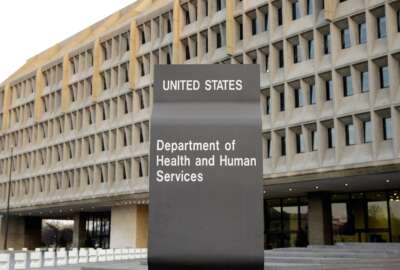
How well did HHS protect unaccompanied children from COVID-19?
The early days of the COVID pandemic were chaotic, you might say. Health and Human Services was as busy as any agency. Among its tasks, ensuring unaccompanied c...
Best listening experience is on Chrome, Firefox or Safari. Subscribe to Federal Drive’s daily audio interviews on Apple Podcasts or PodcastOne.
The early days of the COVID pandemic were chaotic, you might say. Health and Human Services was as busy as any agency. Among its tasks, ensuring unaccompanied children taken in at U.S. borders were kept in environments safe from the disease. How did the agency do? To find out, Federal News Network’s Eric White spoke with HHS Assistant Regional Inspector General, Sylvie Witten on the Federal Drive with Tom Temin.
Interview transcript:
Sylvie Witten: We actually conducted this audit by making site visits to the one influx care facility and the 10 emergency intake sites that were fully operational at the time of our audit when we were starting. And during these site visits, we conducted a walk-through of each facility actually putting our eyes on the different rooms and different setups and things that they had going on in these facilities. And we were observing such things as the overall facility layout, the children’s living conditions, services being provided to children, the COVID-19 precautionary measures that were in place, which would include things such as distancing and mask wearing, things that we could physically observe, and an overall observation of how the facility was handling COVID-19 and COVID-19 cases. We also had a series of interview questions that we asked the facility officials so that we could gain even a better understanding of certain things, including the services provided to children, the COVID-19 policies and procedures that were being used by each facility, how COVID-19 testing and reporting was being done, and any challenges that the facilities were facing with respect to COVID-19. And as far as the facilities that we visited, the one influx care facility, and six of the emergency intake sites were actually in Texas, three of the emergency intake sites were in California, and one emergency intake site was in Michigan. And we made our visits to those sites during May and June of 2021.
Eric White: So the COVID-19 protocols was, you were looking at overall, you know, how children were being cared for. But the COVID-19 protocols were kind of the main focus point?
Sylvie Witten: Correct. The main focus of this audit was COVID-19. And the protocols and protections that were in place for these children during the pandemic, yes. Well, focused on when we were there, and what we could observe, and then an overall understanding of how they were actually managing COVID with respect to taking care of these children.
Eric White: And from your observations, how are they doing? And, you know, in dealing with an unprecedented crisis, what were some of the observations you all made?
Sylvie Witten: So I think one of the main overall observations was, it was a difficult time, right. Things were moving quickly. And not all facilities, facilities could have been doing more to protect against COVID-19. And part of that had to do with the Office of Refugee Resettlement didn’t really have a good place, process in place for disseminating the guidance, and any updates to those to the guidance to these facilities. And so unfortunately, some of the emergency intake site officials had some confusion or difficulty knowing what COVID-19 protocols and guidance they needed to implement within their facility. But for the most part, the facility officials were trying to take the necessary precautions against COVID-19. And take care of these kids. They just weren’t always fully aware of the recommended precautions that they needed to take. And I mean, we had a number of findings, as you can tell in the report related to some of these recommendations not being implemented or fully implemented.
Eric White: Yeah. And I mean, I imagine, you know, everybody, nobody really knew what was going on in the early days, I imagined it or I’m wondering, is this, do they have any training in the beginning, when they are on-boarded, as far as you know, if there is some sort of outbreak, obviously not COVID-19. But you know, there’s still flu outbreaks that happened in Texas and things like that, is there any protocols that were in place for anything kind of like this?
Sylvie Witten: So the protocols that ORR had in place were more geared to their network care providers that are always in place, and even some procedures in place for the influx care facility because those get opened and closed as needed. The difficulty was that these emergency intake sites were a new type of facility, they weren’t state licensed. And so they really were trying to put together guidance and recommendations for these facilities for this pandemic, which is, you know, nobody saw COVID coming, right? So while they may have had and I can’t speak to that, what protocols they might have had in place for flu and things like that. I’m sure they probably did at their normal network care of providers, but this was new and they were the emergency intake sites were a new type of facility, and not all of what was required of their normal facilities, normal care provider facilities that their standard network care was being required of the emergency intake sites. Because some of it, the difference being, there’s a big difference in not being state licensed and some of the things that they can require. So they were trying to quickly develop protocols and procedures that were going to be required at these emergency intake sites during this pandemic.
Eric White: And as part of that, with these intake sites, what part of the actual intake process were they? Well, what part of that were they trying to accommodate for COVID-19 protocols?
Sylvie Witten: Most facilities, were testing the kids upon intake and trying to, you know, mitigate the spread that way, if they were positive, then they could, you know, manage them a certain way. If they were negative, they still were at being asked to quarantine them and you know, watch them for a few days and then test them again to make sure they’re still negative before putting them into the general population. And so there were recommendations being made for intake and how they should manage these kids and the things that they should do. It’s just that they weren’t, not all facilities were doing what was recommended. And like I said, some of that came from not having a full understanding of the expectation.
Copyright © 2024 Federal News Network. All rights reserved. This website is not intended for users located within the European Economic Area.
Tom Temin is host of the Federal Drive and has been providing insight on federal technology and management issues for more than 30 years.
Follow @tteminWFED
Related Stories





